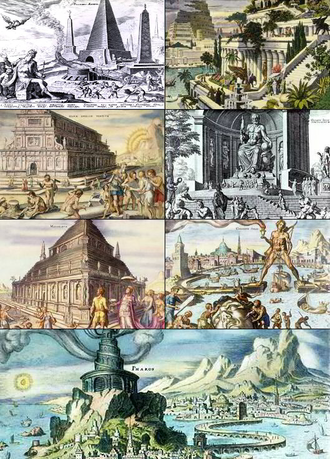Losing the art of wonder
 Ah, the Seven Wonders of the Ancient World. Far nicer, I suspect, than whatever might qualify as the Seven Wonders of the Modern World possibly including, say, West Edmonton Mall. But what were they again?
Ah, the Seven Wonders of the Ancient World. Far nicer, I suspect, than whatever might qualify as the Seven Wonders of the Modern World possibly including, say, West Edmonton Mall. But what were they again?
The Colossus of Rhodes, I think. The Hanging Gardens of Babylon? Definitely the Great Pyramid of Giza, which was even greater when it had its shining white limestone casing. Some lighthouse or another. And um… um… The Temple of Artemis in Ephesus in Asia Minor.
I gather it was like a Greek temple only more so. The acme of Greek templeness. Rows of pillars, harmonious proportions, a brilliant architrave (I love that word), a pediment, white marble, probably painted, I bet they had a great statue of the goddess like the one in the Parthenon until the Turks accidentally blew it up.
I say “I gather” rather than “I know” because it’s not there any more. In fact the Temple of Artemis burned down on July 21 of 356 B.C. And as you might imagine if even loosely acquainted with the vanity and folly of the human race, it was arson. Arson inspired by a desire for fame.
A man named Herostratus set the wooden roof beams on fire. (Yes, wooden. Stone, you see, is very strong under compression but very weak under tension which is a fancy way of saying if you put a long piece in the air it will crack on the bottom side and fall on your miscalculating head bone.) He thus became famous, inspiring the term “herostratic fame” among, um, pedants for the kind of fame you get for doing something wicked in order to become famous for being famous for being wicked to become famous. Gloria mundi, I guess.
Incidentally Herostratus was sentenced to death for this idiotic crime, with the provision that nobody should mention his name but even in the absence of Google or Facebook somebody did and now we know of him. It wasn’t the first hard luck the temple had, including a flood in the 7th century B.C., after which it was rebuilt at the expense of Croesus of Lydia, whose fame in the phrase “rich as Croesus” sure beats the herostratic sort.
After Herostratus burned it down, it was rebuilt in its definitive “Wonder” form in which it endured for centuries before the Goths definitively trashed it in another typically human act of vainglorious destruction. Their name too lives on though not, except to devotees, in a good way.
By the way, I did Google the Seven Wonders and while there was no canonical list they are generally felt to be the Colossus of Rhodes, the Lighthouse of Alexandria, the Mausoleum at Halicarnassus, the Temple of Artemis and the Statue of Zeus, all destroyed, the Great Pyramid, dented but intact, and the Hanging Gardens, location unknown and existence disputed.
As for the temple of Artemis, we know it only from fragments and foundations, plus various efforts to reconstruct what it might have looked like including one at Miniaturk Park in Istanbul. But people still go to look at the fragments and the reconstructions. Which is more than they’ll ever do for the stuff we build.
Tourists at the foundations of the West Edmonton Mall in 4000 AD, or that ugly pyramid at the Louvre? I don’t think so.